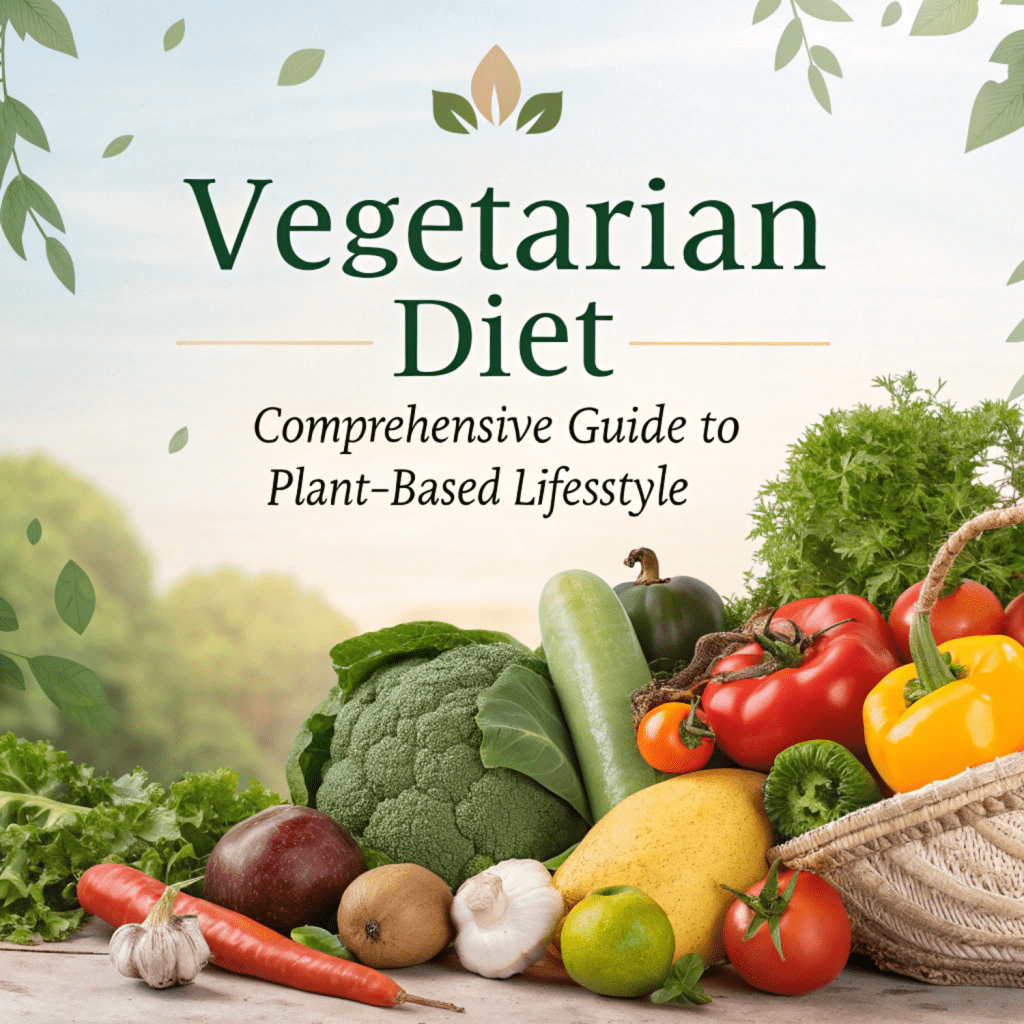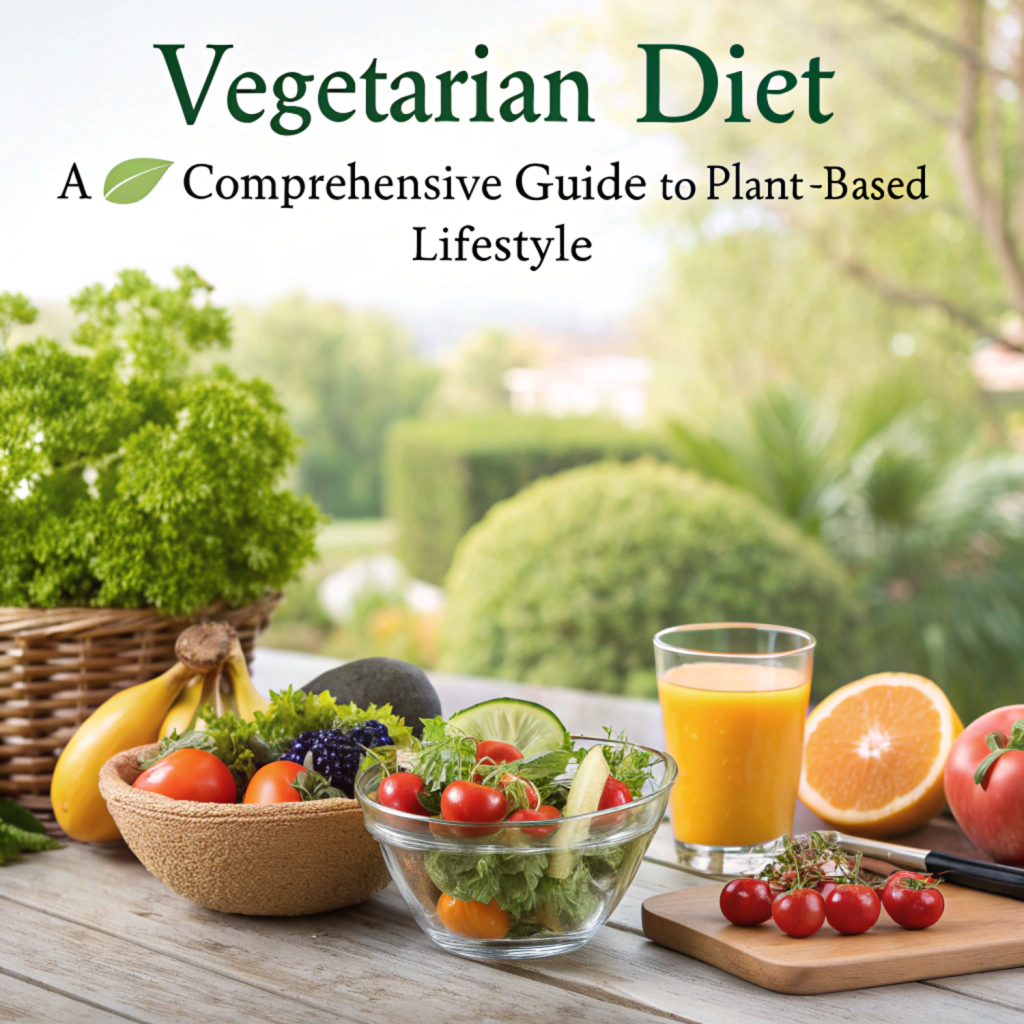
Vegetarian diets have surged in popularity as people seek healthier, more sustainable ways of eating. This comprehensive guide explores the vegetarian diet, its origins, how to adopt it, its nutritional benefits, and key considerations for maintaining a balanced lifestyle. Whether you’re curious about going meat-free or already embracing this lifestyle, this article provides everything you need to know about the vegetarian diet.
What Is a Vegetarian Diet?
A vegetarian diet excludes meat, poultry, fish, and other animal flesh but often includes plant-based foods like fruits, vegetables, grains, legumes, nuts, and seeds. Some vegetarians incorporate dairy and eggs, while others follow stricter variations, such as veganism, which excludes all animal products. The vegetarian diet emphasizes whole, nutrient-rich foods that support health and environmental sustainability.
Types of Vegetarian Diets
Several variations of the vegetarian diet exist, each with distinct guidelines:
- Lacto-vegetarian: Includes dairy products but excludes eggs, meat, and fish.
- Ovo-vegetarian: Includes eggs but excludes dairy, meat, and fish.
- Lacto-ovo vegetarian: Includes both dairy and eggs but no meat or fish.
- Vegan: Excludes all animal products, including dairy, eggs, and honey.
- Pescatarian: Includes fish but excludes other meats (not always considered strictly vegetarian).
- Flexitarian: Primarily vegetarian but occasionally includes meat or fish.
Each type allows flexibility to suit individual preferences, health needs, and ethical beliefs.
Origins of the Vegetarian Diet
The vegetarian diet has deep historical and cultural roots, spanning centuries and continents. Its origins trace back to ancient civilizations, where plant-based eating was often tied to religious, ethical, or philosophical beliefs.
Ancient Beginnings
In ancient India, vegetarianism emerged around the 6th century BCE, driven by religious teachings like Jainism, Hinduism, and Buddhism. These philosophies emphasized ahimsa (non-violence), encouraging followers to avoid harming animals. The Indian subcontinent remains a global hub for vegetarianism, with millions adhering to plant-based diets today.
In ancient Greece, philosophers like Pythagoras advocated for vegetarianism, believing it promoted health and ethical living. Pythagoras, often called the “father of vegetarianism,” influenced early Western thought on meat-free diets.
Modern Vegetarian Movement
The modern vegetarian movement gained traction in the 19th century. In 1847, the Vegetarian Society was founded in England, formalizing the term “vegetarian” and promoting plant-based eating for health, ethics, and environmental reasons. The movement spread globally, with vegetarianism becoming a mainstream choice by the 20th century.
Today, vegetarian diets thrive worldwide, driven by concerns about health, animal welfare, and climate change. Countries like India, Israel, and parts of Europe have significant vegetarian populations, and plant-based options are increasingly available in restaurants and grocery stores.
How to Start a Vegetarian Diet
Adopting a vegetarian diet is straightforward with proper planning. Follow these steps to transition smoothly and ensure nutritional balance:
1. Set Your Goals
Decide why you want to follow a vegetarian diet. Are you motivated by health, ethics, or environmental concerns? Clear goals help you stay committed and choose the right variation of the diet.
2. Start Gradually
Ease into vegetarianism to make the transition sustainable:
- Begin with “Meatless Mondays” or reduce meat consumption a few days a week.
- Experiment with vegetarian recipes to discover new flavors and dishes.
- Replace meat with plant-based proteins like beans, lentils, or tofu.
3. Plan Balanced Meals
A well-planned vegetarian diet includes a variety of foods to meet nutritional needs:
- Fruits and vegetables: Aim for a colorful mix to get a range of vitamins and minerals.
- Whole grains: Choose quinoa, brown rice, oats, or whole-grain pasta for fiber and energy.
- Proteins: Incorporate beans, lentils, chickpeas, tofu, tempeh, or seitan.
- Healthy fats: Add avocados, nuts, seeds, and olive oil for heart health.
- Dairy or alternatives: Use milk, yogurt, or plant-based options like almond or soy milk.
4. Learn Vegetarian Cooking
Explore vegetarian recipes to keep meals exciting and diverse. Try these beginner-friendly dishes:
- Vegetarian chili: Combine beans, tomatoes, and spices for a hearty meal.
- Stir-fried tofu and vegetables: Sauté tofu with broccoli, peppers, and soy sauce.
- Lentil soup: Simmer lentils with carrots, celery, and herbs for a comforting dish.
5. Stock Your Kitchen
Keep your pantry stocked with vegetarian staples:
- Canned or dried beans (black, kidney, chickpeas)
- Grains (rice, quinoa, barley)
- Nuts and seeds (almonds, chia, flax)
- Spices and herbs for flavor
- Plant-based milk and yogurt
6. Educate Yourself
Learn about vegetarian nutrition to avoid deficiencies. Consult a dietitian if needed, especially when transitioning to veganism or during pregnancy.
7. Stay Flexible
Allow room for occasional slip-ups or adjustments. If you’re flexitarian, you might include meat occasionally without guilt. The goal is a sustainable, enjoyable diet.
Nutritional Benefits of a Vegetarian Diet
A vegetarian diet offers numerous health benefits when well-planned. It’s rich in nutrients and low in saturated fats, making it a heart-healthy choice. Below are key nutritional advantages:
1. High in Fiber
Fruits, vegetables, whole grains, and legumes are fiber-rich, promoting digestive health, stabilizing blood sugar, and supporting weight management. Fiber also lowers cholesterol levels, reducing heart disease risk.
2. Rich in Vitamins and Minerals
Vegetarian diets emphasize nutrient-dense foods:
- Vitamin C: Found in citrus fruits, peppers, and leafy greens, it boosts immunity.
- Vitamin E: Present in nuts and seeds, it supports skin and heart health.
- Potassium: Bananas, spinach, and potatoes help regulate blood pressure.
- Magnesium: Found in legumes and whole grains, it aids muscle and nerve function.
3. Low in Saturated Fats
By excluding or limiting animal products, vegetarian diets reduce saturated fat intake, lowering the risk of heart disease and stroke. Plant-based fats, like those in avocados and nuts, are heart-healthy.
4. Supports Weight Management
Vegetarian diets are often lower in calories and higher in fiber, helping you feel full longer. Studies show vegetarians tend to have lower body mass indexes (BMIs) than non-vegetarians.
5. Reduces Chronic Disease Risk
Research links vegetarian diets to lower risks of:
- Heart disease: Due to reduced cholesterol and blood pressure.
- Type 2 diabetes: High fiber and low glycemic foods improve blood sugar control.
- Certain cancers: Plant-based diets rich in antioxidants may lower cancer risk.
6. Environmentally Friendly
Vegetarian diets require fewer resources like water and land compared to meat-based diets. They also produce fewer greenhouse gas emissions, making them a sustainable choice for the planet.

Key Nutrients to Monitor
While vegetarian diets are nutrient-rich, certain nutrients require attention to avoid deficiencies:
1. Protein
Plant-based proteins like beans, lentils, tofu, and quinoa meet protein needs. Aim for 0.8 grams of protein per kilogram of body weight daily. Combine complementary proteins (e.g., rice and beans) for complete amino acid profiles.
2. Vitamin B12
B12 is primarily found in animal products, so vegetarians may need fortified foods (cereals, plant-based milk) or supplements. Deficiency can cause fatigue and neurological issues.
3. Iron
Plant-based iron (non-heme) is less absorbable than animal-based iron. Eat iron-rich foods like spinach, lentils, and fortified cereals with vitamin C-rich foods (e.g., oranges) to enhance absorption.
4. Omega-3 Fatty Acids
Found in fish, omega-3s are limited in vegetarian diets. Include flaxseeds, chia seeds, walnuts, or algae-based supplements for heart and brain health.
5. Calcium
Dairy provides calcium, but vegans can get it from fortified plant milks, tofu, kale, or almonds. Aim for 1,000–1,200 mg daily to support bone health.
6. Vitamin D
Sun exposure and fortified foods (milk, orange juice) provide vitamin D. Supplements may be necessary, especially in winter or for those with limited sun exposure.
7. Zinc
Found in legumes, nuts, and whole grains, zinc supports immunity. Soak or sprout grains and legumes to improve zinc absorption.
Sample Vegetarian Meal Plan
Here’s a balanced one-day vegetarian meal plan to inspire your journey:
Breakfast
- Oatmeal with almond milk, berries, and chia seeds
- Whole-grain toast with avocado
- Black coffee or herbal tea
Lunch
- Quinoa salad with chickpeas, cucumber, tomatoes, and feta
- Mixed greens with olive oil and lemon dressing
- Apple slices
Snack
- Handful of almonds and a banana
- Greek yogurt (or plant-based yogurt for vegans)
Dinner
- Lentil and vegetable curry with brown rice
- Steamed broccoli with garlic
- Fresh mango for dessert
Evening Snack
- Hummus with carrot and celery sticks
This plan provides a balance of protein, fiber, healthy fats, and micronutrients.
Common Challenges and Solutions
Transitioning to a vegetarian diet can present challenges. Here’s how to address them:
1. Cravings for Meat
- Use meat substitutes like tempeh, seitan, or plant-based burgers.
- Experiment with umami-rich foods like mushrooms or soy sauce to mimic savory flavors.
2. Social Situations
- Communicate your dietary needs when dining out or attending events.
- Offer to bring a vegetarian dish to share at gatherings.
3. Nutrient Deficiencies
- Track your nutrient intake using apps or consult a dietitian.
- Consider a multivitamin or targeted supplements (e.g., B12, iron).
4. Limited Restaurant Options
- Research vegetarian-friendly restaurants in advance.
- Customize dishes by asking for meat-free versions or plant-based substitutions.
Vegetarian Diet and Special Populations
Vegetarian diets suit most people but require extra care for certain groups:
Pregnant Women
- Ensure adequate iron, B12, and omega-3s for fetal development.
- Consult a healthcare provider for personalized guidance.
Children and Teens
- Provide nutrient-dense foods to support growth.
- Monitor B12, iron, and calcium intake.
Athletes
- Focus on high-protein foods like lentils, tofu, and quinoa.
- Include complex carbs (e.g., sweet potatoes) for energy.
Older Adults
- Prioritize calcium and vitamin D for bone health.
- Choose easy-to-digest proteins like smoothies or soft legumes.
Environmental and Ethical Benefits
Beyond health, vegetarian diets align with ethical and environmental goals:
- Animal welfare: Reduces demand for factory farming, promoting humane treatment.
- Sustainability: Lowers carbon footprint and conserves natural resources.
- Biodiversity: Decreases deforestation linked to livestock farming.
Tips for Long-Term Success
Stay committed to your vegetarian diet with these strategies:
- Join vegetarian communities online or locally for support and recipe ideas.
- Experiment with global cuisines, like Indian, Mediterranean, or Ethiopian, which offer naturally vegetarian dishes.
- Keep learning about nutrition to refine your diet over time.
- Celebrate small milestones, like trying a new vegetable or mastering a recipe.
A vegetarian diet offers a wealth of health, ethical, and environmental benefits. By understanding its origins, planning balanced meals, and addressing nutritional needs, you can thrive on a plant-based lifestyle. Whether you’re reducing meat for health or fully committing to vegetarianism, this diet provides a sustainable, nutrient-rich path to better living. Start your vegetarian journey today and discover the vibrant world of plant-based eating!

